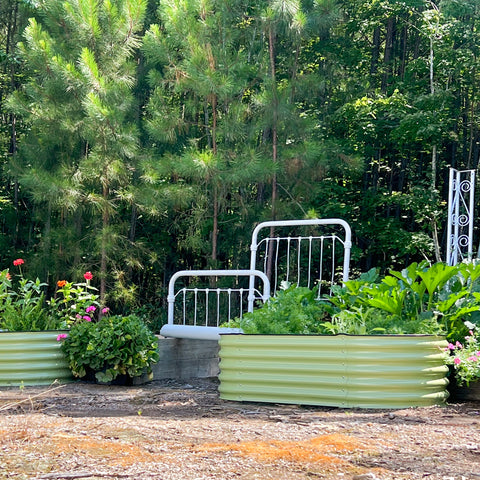Tips from Olle Garden Bed: How to Make Leeks Live Through Winter
Leek is an undervalued vegetable, which should be put together with onions and garlic in the Pantheon of onions. They are not only rich in onion flavor, but also easy to grow. Compared with other vegetables, they can survive the winter very well. The following content also has some reference value for raised garden beds.
Most leek varieties are very cold resistant; Just look for varieties that take longer to mature - they tend to tolerate frost better than fast-growing varieties that are ready to harvest in 100 days. But as long as there is some winter protection, any leek can persist in winter. Read the following to learn more about the cold resistance of leeks and how to provide them with adequate protection to survive the cold months.

Can leeks survive winter?
Generally speaking, leeks can survive the winter. Most leek varieties can survive in deep frost as low as 12.2 ° F (- 10 ° C) without any protection. They can also survive in colder temperatures, depending on snow (insulation), rain and storm dew, and the time they are exposed to these very cold temperatures. Under protection, many cold resistant leek varieties can survive even in the coldest winter.
There are several variables that affect the viability of Chinese chives in winter. First, the lowest temperature in winter. Most species can sustain winter temperatures of 12.2 ° F (- 10 ° C) without protection. Whether they can survive the deeper frost will depend on how long they are exposed (even some less hardy varieties can survive the very deep temporary frost) and how much protection they have. The leek buried under the snow has some natural insulation effect on the cold temperature. The key to surviving winter is not to freeze the roots of leeks.
Note: Chives planted in flowerpots are more likely to kill frost, because the chances of freezing roots and killing plants are higher. Keep the flowerpots away from windy areas, or place them near the south facing wall of your home to make them slightly warmer.
Different varieties of chives have different degrees of cold resistance in winter. The following is an example of leek varieties and their killing frost temperature, taken from the annual winter killing list of sustainable market agriculture [1]. It is strongly recommended that you check, as it lists the different vegetables and the temperatures at which they may die without additional protection.
12 ° F (- 11 ° C): Lincoln, Richard Germany
Wang 10 ° F (- 12 ° C): American flag (Broad London), JaunedePoiteau
5 ° F (- 15 ° C): Bulgarian Giant, Laura 0 ° F (- 18 ° C): Alaska, Dura
Bell, Tadona
Other cold resistant leek varieties not listed: Giant Bengbao, bandits
Increased protection, such as thick (at least a few inches) leaf mulch or straw, can greatly improve the viability of leeks.
Will leeks come back every year?
Chives are perennial plants, so they will come back every year, but they will bloom the next year and produce lateral buds year after year. However, they are usually grown annually or biennially.
Generally speaking, people grow chives like onions, which are planted in early spring and harvested in late summer, autumn or early winter. In areas with mild winter, they can even be harvested in the next spring. The chives will blossom in the next year, and the tough flower stems will be produced in the middle. Therefore, it is best to harvest chives before the flower stems begin to grow, so as to maximize the flavor and texture of the chives.
However, leeks are not biennial like onions, but real perennial plants. If they are placed underground for a long time, they will produce lateral buds [2]. Some gardeners intentionally let them grow lateral branches, so that they can harvest tender leek buds or separate them and plant perennial leek fields.
Can I leave leeks in the fields for winter?
Chives can be left underground for winter. If you don't have a root cellar, this is the easiest way to "store" chives for winter harvest. Let leeks cover and keep them alive throughout the winter.
Because they are perennial plants, they can stay underground for winter as annual plants/biennial plants, but they need protection to survive in the extremely cold winter. If you plan to harvest chives from winter to early spring, this is actually the easiest way to store chives.
Or, if you can use cold root cellars, you can store them in soil or sand for several months [3].

How to Protect Leek in Winter
If you live in a cold area in winter, please keep the leek well covered in winter, either climb the mountain with soil or cover it with leaves or straw. If you plant leeks in the container, please cover them and move the container out of the wind. It is better to be close to the south facing wall of your home, where the microclimate is mild.
Even the hardest chives need protection to survive in extremely cold weather (think of the polar vortex cold temperature). As a general rule, if you plan to keep leeks alive throughout the winter, you should cover them.
Stacking at least half of the straw with soil will provide additional frost protection for the crown and root. However, if you plan to harvest in winter rather than just in spring, it is more convenient to use thick leaf mulch or straw when you want to dig them in the middle of winter.
Note that if you live in an area with heavy snowfall, a thick layer of snow can be used as a cover and protect the roots from the cold air above.
